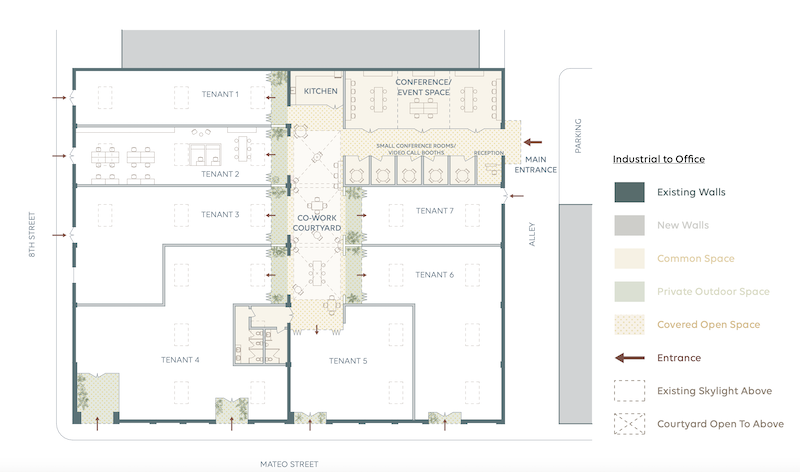The Los Angeles-based design firm Omgivning has released three white papers that propose new ways, post-COVID 19 pandemic, of looking at workplaces, multifamily, and urban reprogramming.
The firm’s ideas revolve around four unifying themes:
• Human-centric design
• Flexibility and adaptability
• Blended uses
• The relationship of space and economic context
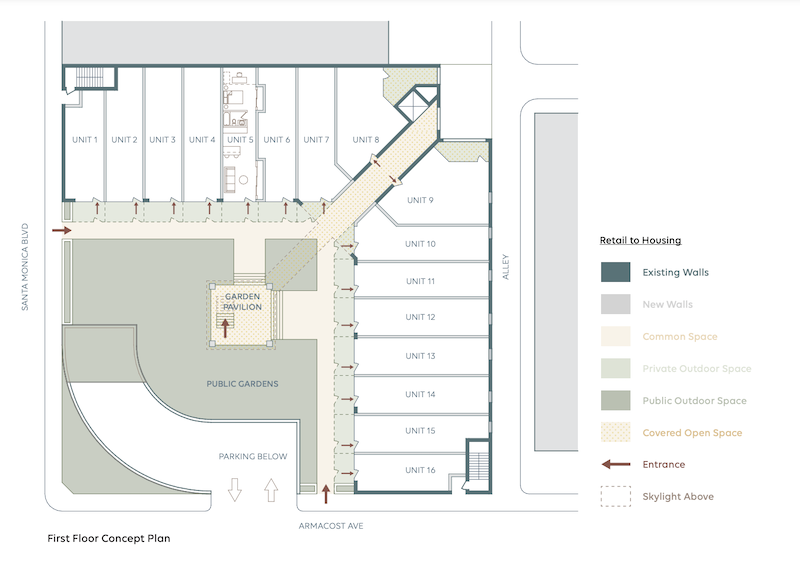
Big-box retail, which is under stress from online shopping, could be rethought for residential conversion with lots of open public areas.
Karin Liljegren, FAIA, IIDA, Omgivning’s founder and Principal, in 1999 worked on the very first projects under Los Angeles’ Adaptive Reuse Ordinance. Her firm’s recent white papers assume that changing social norms have created excess and unused capacity in the built environment. Those assumptions drive the various alternative concepts that Omgivning has devised, with an eye always toward reusing, as opposed to tearing down, existing buildings.
For example, Omgivning’s multifamily paper cites Preservation Positive, a report released by the LA Conservancy in 2020, that approximately three-fifths of Angelenos rent while the city remains in the middle of an ongoing housing crisis. “Rather than build itself out of this crisis, where the average cost to produce one new unit of subsidized affordable housing is at least $400,000, we should seek to find a more cost-effective, creative, and sustainable approach. Through enhancing the city's residential stock in existing buildings, we can help fill the gap toward achieving the City's housing goals.”
BREAKING DOWN THE MULTIFAMILY FORM
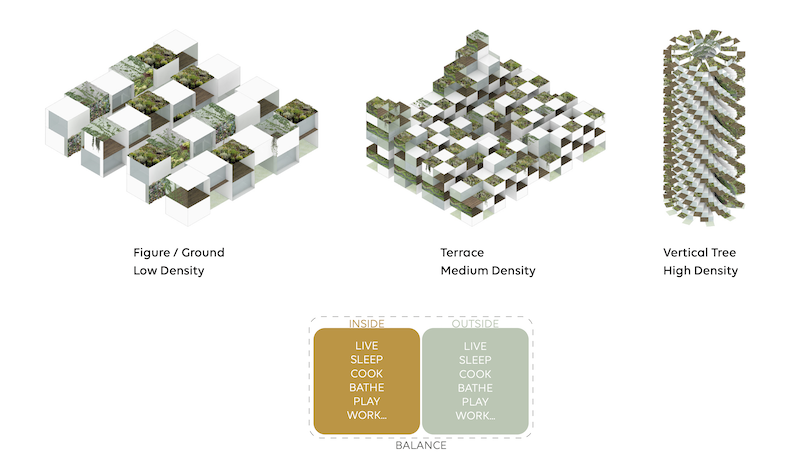
Multifamily buildings can achieve different density levels, depending on the amenities and biophilia included.
The multifamily paper offers four concepts:
• Humanizing the urban experience by providing features for existing urban apartment buildings that contribute to a greener, more porous city;
• Expanding unit types through designs that integrate diversity and flexibility into spaces for the inhabitants' various needs;
• Common spaces that emphasize a connection to nature, expand private work options in communal environments, and introduce on-site commerce; and
• Transforming interiors whose components are designed to be "both/and" solutions to meet multiple needs, as opposed to "either/or" that only allow for a single use.
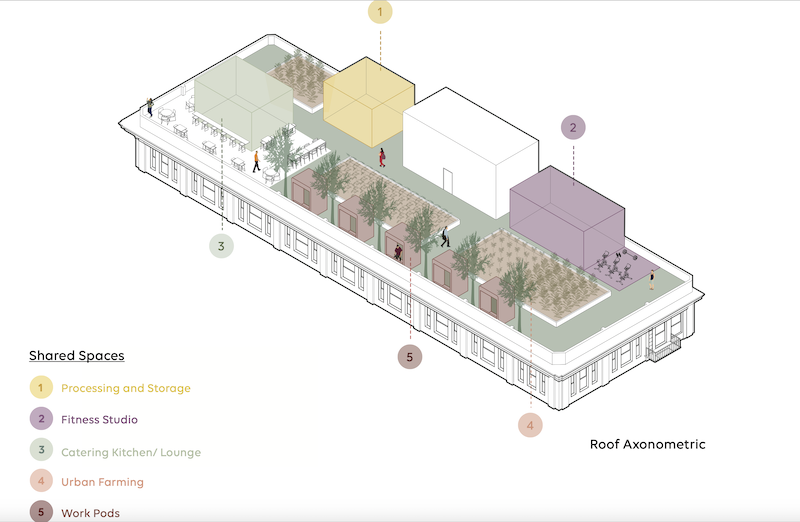
Shared and common spaces that could include roofdeck “work pods” are central to Omgivning's multifamily concepts.
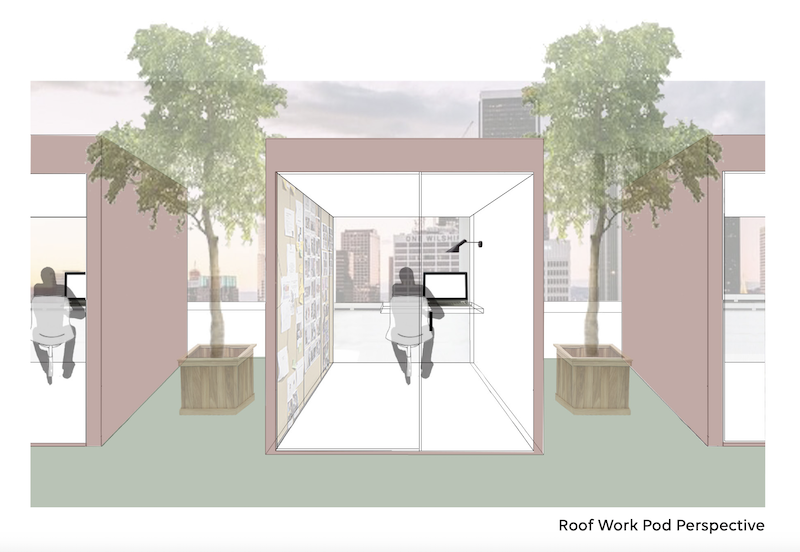
The paper deconstructs the multifamily form to incorporate open-ended light courts that allow natural light and ventilation to flow throughout. Its concepts expand the unit types within buildings to include two-story two-family, as well as private and “gather” zones.
“Opportunities also exist to create new experiences and interactions in areas once relegated to back of house,” the paper states, “or typically common to the street and sidewalk.” That might include relocating the mailroom to the front of the building and adding refrigerated boxes and larger parcel rooms. “Even the simple act of picking up mail presents a greater chance of engaging with neighbors.”
PODS FOR DIFFERENT USES
Omgivining is a big advocate for incorporating “pods” into its reimagining of buildings for privacy and utility. Pods are part of one of the firm’s alternate multifamily unit types. And Omgivning’s workplace paper presents three pod types that accommodate a broad range of needs:
The View Pod, designed for maximum resilience that supports unexpected shelter-in-place requirements. Enclosed on all sides with one main opening directed towards a chosen view, these pods could face exterior windows or a common open space within the office. In its workspace scenario, The View ensures privacy and sound isolation, while remaining visually connected to elements beyond. The sleep scenario can host a mattress for an overnight stay.
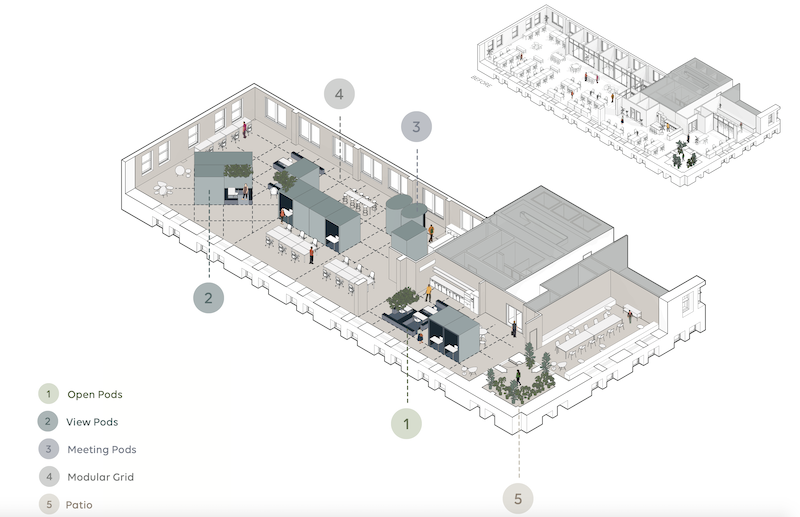
Omgivning reimagines the workplace with different kinds of intimate spaces, such as its “work-meet” pod that allows for privacy and collaboration.
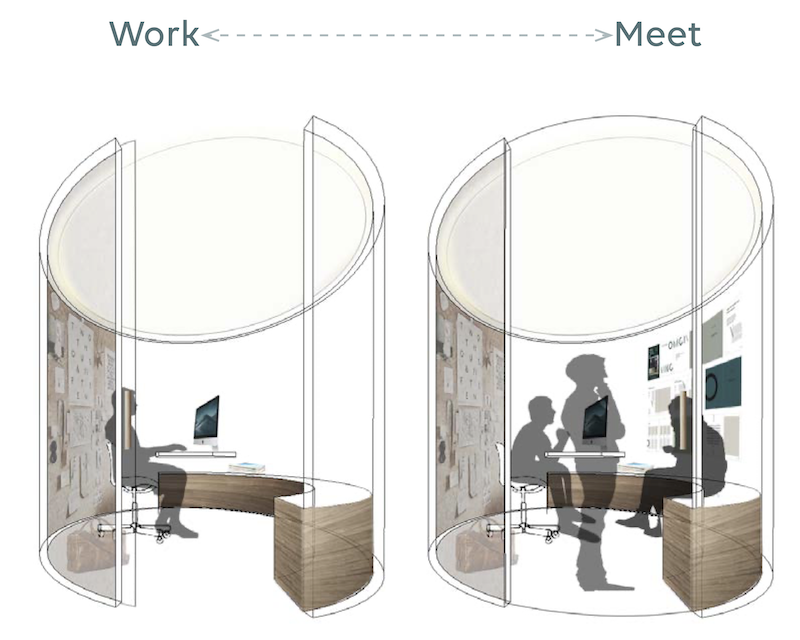
The Meeting Pod, which provides flexibility for open or enclosed meetings. Its circular footprint provides acoustic privacy for video calls and to aid in focus. Built-in millwork offers dual functions for seating and storage. Integrated lighting and tackable surfaces present a clean background for personalization and work-based pin-ups.
The Open Pod, which provides a modular footprint with varying barrier preferences. It defines an individual space while staying visually connected to the communal space. The barrier preferences are adjustable to an open or enclosed layout, based on the occupant's needs. Greenery, suspended from above or in planters, can be used to define zones and remind inhabitants to prioritize wellbeing. The Open Pod provides built-in lockers, open shelving and the option for a height-adjustable desk.
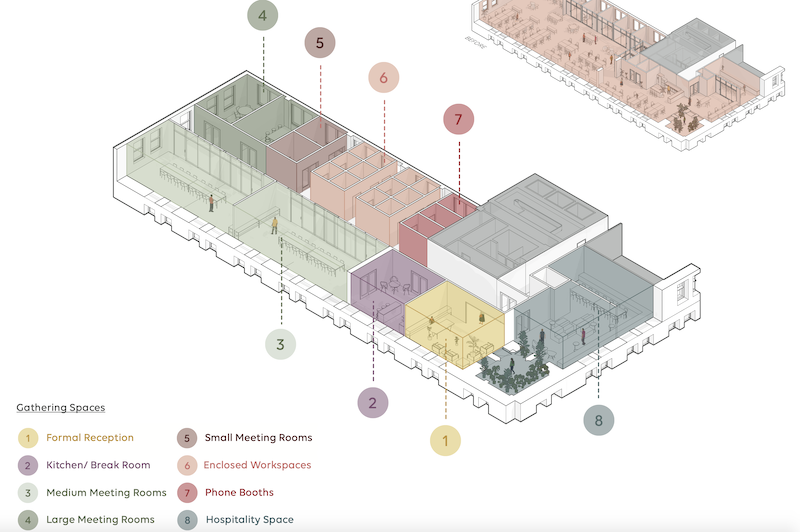
The workplace needs places where employees can still congregate safely.
The workplace paper also offers reuse concepts for gathering spaces and for better infection control, the latter of which helps employers assess workers’ needs by developing targeted protocols that focus on human impacts.
REVIVING TIRED RETAIL AND WAREHOUSE SPACE
In its paper on reimagining urban reprogramming, Omgivning cites experts who anticipate that 90% of real estate development over the next decade will focus on renovation and resuse, rather than new construction.
To that end, this paper proposes ways to transform struggling strip malls (there are 675 malls in Los Angeles alone), big-box retail (using an existing vacant 150,000-sf Costco in L.A. as its starting point), light-industrial warehouses, and urban ground-floor commercial space.
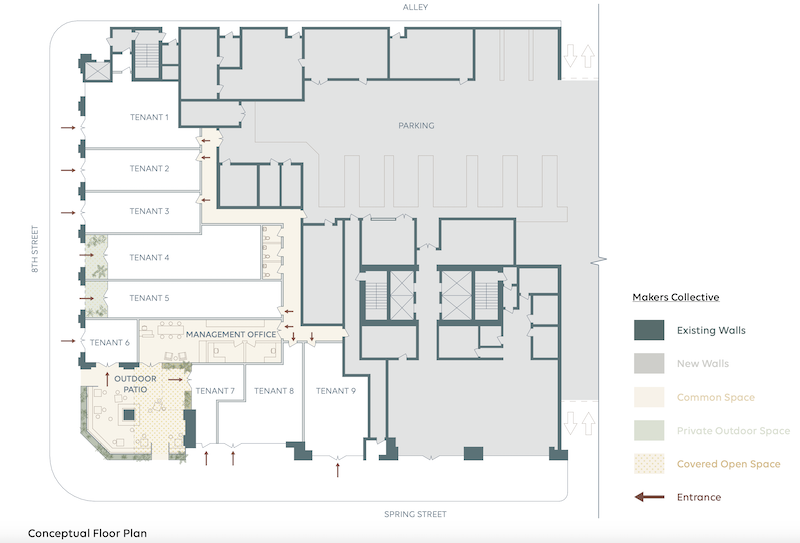
Light industrial space could be converted to leasable maker spaces.
Its vision for converting retail space to housing includes one configuration showing a mini-mall with the capacity to hold 30 600-sf affordable residential units, each outfitted with work-from-home capabilities, and an outdoor patio or courtyard.
Omgivning’s reuse of light industrial space includes an office concept that’s organized around a centrally located courtyard that provides users with cross ventilation, natural light, and connection to green outdoor space. It also conceived a live-work concept that carves up the building into smaller, more affordable lofts that are linked through outdoor courtyards, and are circulation-rich with greenery.

Restaurants and offices share some common traits that could be combined for converting ground-floor retail.
Transforming ground-floor retail could encompass what Omgivning calls a Makers Collective concept, where a master tenant, or even an existing building management company, can lease a large space and subdivide it into smaller units for individuals or small startups. The program consists of shared space to house equipment needed by the tenants, and a shared space for events and periodic showcases of the community’s products. An outdoor lounge and garden provide a communal gathering space.
Omgivning even goes so far as to suggest a restaurant/office hybrid concept that reduces each footprint by sharing the varied seating arrangements within a restaurant to accommodate individual and collaborative work.
Related Stories
Office Buildings | Sep 28, 2023
Structural engineering solutions for office-to-residential conversion
IMEG's Edwin Dean, Joe Gulden, and Doug Sweeney, share seven key focuses for structural engineers when planning office-to-residential conversions.
Adaptive Reuse | Sep 19, 2023
Transforming shopping malls into 21st century neighborhoods
As we reimagine the antiquated shopping mall, Marc Asnis, AICP, Associate, Perkins&Will, details four first steps to consider.
Adaptive Reuse | Sep 15, 2023
Salt Lake City’s Frank E. Moss U.S. Courthouse will transform into a modern workplace for federal agencies
In downtown Salt Lake City, the Frank E. Moss U.S. Courthouse is being transformed into a modern workplace for about a dozen federal agencies. By providing offices for agencies previously housed elsewhere, the adaptive reuse project is expected to realize an annual savings for the federal government of up to $6 million in lease costs.
Office Buildings | Sep 14, 2023
New York office revamp by Kohn Pedersen Fox features new façade raising occupant comfort, reducing energy use
The modernization of a mid-century Midtown Manhattan office tower features a new façade intended to improve occupant comfort and reduce energy consumption. The building, at 666 Fifth Avenue, was originally designed by Carson & Lundin. First opened in November 1957 when it was considered cutting-edge, the original façade of the 500-foot-tall modernist skyscraper was highly inefficient by today’s energy efficiency standards.
Adaptive Reuse | Sep 13, 2023
Houston's first innovation district is established using adaptive reuse
Gensler's Vince Flickinger shares the firm's adaptive reuse of a Houston, Texas, department store-turned innovation hub.
MFPRO+ Research | Sep 11, 2023
Conversions of multifamily dwellings to ‘mansions’ leading to dwindling affordable stock
Small multifamily homes have historically provided inexpensive housing for renters and buyers, but developers have converted many of them in recent decades into larger, single-family units. This has worsened the affordable housing crisis, say researchers.
Adaptive Reuse | Aug 31, 2023
New York City creates team to accelerate office-to-residential conversions
New York City has a new Office Conversion Accelerator Team that provides a single point of contact within city government to help speed adaptive reuse projects. Projects that create 50 or more housing units from office buildings are eligible for this new program.
Adaptive Reuse | Aug 31, 2023
Small town takes over big box
GBBN associate Claire Shafer, AIA, breaks down the firm's recreational adaptive reuse project for a small Indiana town.
Adaptive Reuse | Aug 17, 2023
How to design for adaptive reuse: Don’t reinvent the wheel
Gresham Smith demonstrates the opportunities of adaptive reuse, specifically reusing empty big-box retail and malls, many of which sit unused or underutilized across the country.
Adaptive Reuse | Aug 16, 2023
One of New York’s largest office-to-residential conversions kicks off soon
One of New York City’s largest office-to-residential conversions will soon be underway in lower Manhattan. 55 Broad Street, which served as the headquarters for Goldman Sachs from 1967 until 1983, will be reborn as a residence with 571 market rate apartments. The 30-story building will offer a wealth of amenities including a private club, wellness and fitness activities.


